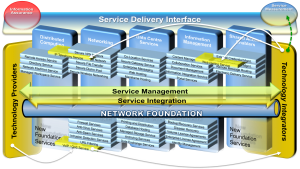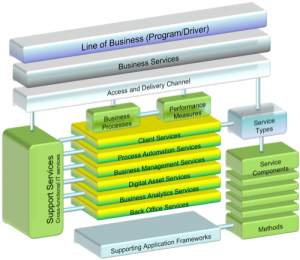Technology Planning involves a sound understanding of the IT investments which have been made and their application in terms of the lines of business they serve. The adoption of a formal methodology is often applied, or developed using a hybrid approach whereby elements of multiple methodologies are combined. This allows clients to develop an Enterprise Architecture plan uniquely aligned to their enterprise.
To assist clients, creating a perspective which aligns services to technology is a major skill used in the formulation of technology architecture blueprints (the “As-Is”), and the development of the technology road-map (the “To-Be” vision). Often a taxonomy is developed to help define the approach using a formal methodology (i.e. TOGAF), so that technology areas can be developed as shown below:
Depending on the type of client (i.e. private vs public sector), adaptations of a formal methodology are developed which are specific to the services which are delivered within the respective EA model. BTEP, GSRM, PSAM, are all common in the Canadian Federal government. Others, such as NASCIO were developed for specific verticals such as health-care. Regardless of the adaptation; the core principles of the underlying EA methodology remain consistent.
The goal is to create an understanding as to which business lines, consume which technologies by area, which when assembled collectively form business services model as shown below:


